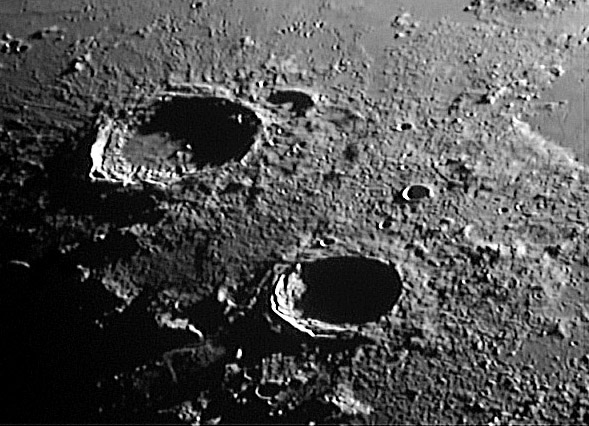Difference between revisions of "June 18, 2004"
| Line 24: | Line 24: | ||
[[iv_098_h2.jpg|Eudoxus: Lunar Orbiter IV View ]] | [[iv_098_h2.jpg|Eudoxus: Lunar Orbiter IV View ]] | ||
</p> | </p> | ||
| − | <p | + | <p><b>Yesterday's LPOD:</b> [[June 17, 2004|Marsh of Epidemics]] </p> |
| + | <p><b>Tomorrow's LPOD:</b> [[June 19, 2004|Janssen]] </p> | ||
</table> | </table> | ||
<!-- start bottom --> | <!-- start bottom --> | ||
Revision as of 12:51, 1 February 2015
Frigid Buddies: Aristoteles and Eudoxus
Image Credit: Cristian Fattinnanzi |
|
Frigid Buddies: Aristoteles and Eudoxus Aristoteles and Eudoxus are two of the largest young craters in the north polar region of the Moon. Aristoteles is 87 km wide and Eudoxus has a diameter of 67 km. These craters look pretty similar, both have terraced walls and hilly floors, apparently veneered with some smooth material - perhaps impact melt. Which is youngest? The larger crater has radial ejecta and secondary craters on nearby Mare Frigoris. These are seen more clearly on the Lunar Orbiter IV frame. Because Eudoxus formed on rubbly Imbrium ejecta, its secondary craters are harder to recognize. The US Geological Survey assigns Eudoxus a stratigraphic age of Copernican, whereas Aristoteles is Eratosthenian. This means that Eudoxus is younger than 1.1 billion years old, and Aristoteles is somewhere between 1.1 and 3.2 b.y. old. Since both craters have about the same number of superposed (subsequent) impact craters, the two craters must be very near the Copernican-Eratosthenian boundary, with one slightly older and the other slightly younger. Technical Details: Related Links: Yesterday's LPOD: Marsh of Epidemics Tomorrow's LPOD: Janssen |
Author & Editor:
COMMENTS?Register, and click on the Discussion tab at the top of the page.
Contributions to http://www2.lpod.org/ are licensed under a Creative Commons Attribution No-Derivative-Works Non-Commercial 3.0 License.
|





